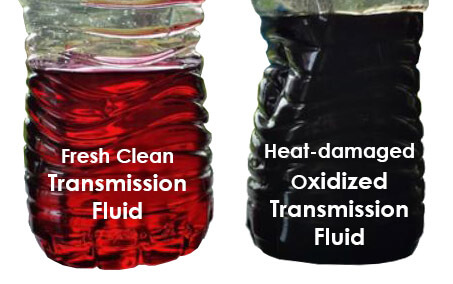When to change transmission fluid
When to change transmission fluid
Many late model cars and trucks don’t list a transmission fluid change interval. Can a transmission fluid really be ok for the life of the transmission? That depends on how you drive. Because how you drive determines how hot the transmission fluid gets and that determines its lifespan.
Yet other transmissions list a frequent transmission fluid change interval, sometimes as often as every 30,000 miles. Do you really have to change fluid that often? YES!
Refer to your Owner’s Maintenance Guide for transmission fluid oil change intervals and follow them to the letter!
You also have to pay attention to how you drive
Transmission fluid life expectancy is based on a running temperature of approximately 175°F. To maintain that temperature, your transmission fluid is cooled by running through an external transmission cooler or a cooling tank at the bottom of your regular radiator (the bottom being the coolest portion of the radiator).
What causes transmission fluid to overheat?
- Towing
- Hauling
- Driving in constant stop-and-go traffic
- Driving in severe heat or cold
- Racing
- Getting stuck and freeing the vehicle by jamming the gears between reverse and drive
- Clogged fins in an external transmission cooler or clogged radiator fins
Transmission life/temperature chart
175°F = life expectancy of 100,000 miles
195°F = life expectancy drops to 50,000 miles
212°F = life expectancy drops to 25,000 miles
235°F = life expectancy drops to 12,000 miles
255°F = life expectancy drops to6,250 miles
275°F = life expectancy drops to 3,000 miles
295°F = life expectancy drops to 1,500 miles
315°F = life expectancy drops to 750 miles
335°F = life expectancy drops to 325 miles
355°F = life expectancy drops to 160 miles
375°F = life expectancy drops to 80 miles
390°F = life expectancy drops to 40 miles
415°F = life expectancy drops to Less than 30 minutes
What happens to overheated fluid
The transmission fluid oxidizes and breaks down
Heat breaks down the anti-oxidation, anti-corrosion and anti-foaming, and seal conditioning additives. Without those additives, the fluid degrades to the point where it no longer lubricates and removes heat from high-friction areas. That causes clutch, band, bushing, valve body and bearing wear.
The high heat and oxidation causes the fluid to form sludge and varnish deposits in high-heat/high-wear areas like the valve body and metal-to-metal contact areas.

The high heat also degrades rubber seals, causing them to harden and crack.
Worn out transmission fluid has a burnt smell, has a dark brown color and in some cases is noticeably thicker than new fluid
What’s the risk in changing old worn out heat-damaged transmission fluid?
As first blush, it seems to make sense that you’d want to remove all that old stinky worn out fluid from your transmission. After all, you’d want to change old worn out oil in your engine.
However, the damage has already been done. The internal parts have already experienced per-mature wear. The sludge and varnish deposits are filling in the clearances between metal parts. The heat-hardened and cracked rubber seals have most likely accumulated particulate matter from worn clutch discs and bands.
If you drain the old fluid and replace with new fluid, the detergents in the new fluid will slowly dissolve the sludge, varnish and particulate matter in your transmission. Sounds good, right? It’s not.
Fresh transmission fluid in an abused transmission can cause total failure
I’ll admit this is an exaggeration; but that sludge and varnish is what’s filling in the wear areas in your transmission. Remove it and you’ll have excessive clearances in the valve body, servos and clutch packs, and that’ll cause pressure leaks, shifting problems and even more heat.
In other words, if you have a transmission with heat-damaged transmission fluid, you may be better off NOT changing it. Changing it can actually cause total transmission failure.
Just purchased a vehicle and don’t know the transmission fluid change history?
Check the condition of the transmission fluid. It’s it’s dark brown, is thicker than normal and has a burnt smell, changing it is risky, especially if the transmission is already experiencing shift issues.
Some shops recommend against performing a full transmission flush in these cases and recommend a pan drop which only removes about a third of the fluid. With only a portion of the fluid replaced, the new fluid can slowly start to recondition the old seals and slowly dissolve the sludge and varnish buildup. If you don’t experience any worse shifting issues, perform another pan drop six months later.
However, if the shifting issues get worse, plan for a transmission rebuild
©, 2014 Rick Muscoplat
Posted on by Rick Muscoplat